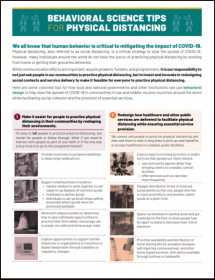Behavioral Sciences Tips for Physical Distancing
This brief includes some concrete tips for how local and national governments and other institutions can use behavioral design to help slow the spread of COVID-19 in communities in low and middle-income countries around the world while facilitating social cohesion and the provision of essential services.
These include:
- Make it easier for people to practice physical distancing in their communities by reshaping their environments.
- Redesign how healthcare and other public services are delivered to facilitate physical distancing while ensuring essential service provision.
- Lower the costs, both social and financial, associated with physical distancing.
- Create new benefits and incentives to make physical distancing less painful and more sustainable for people to practice over time
Last modified: April 24, 2020
Language: English

